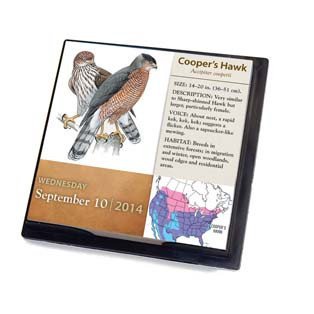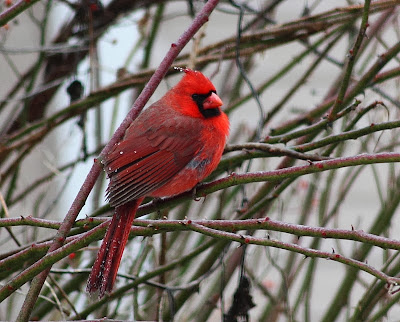It was just a normal morning with me eating breakfast and sipping coffee while enjoying the activity at my bird feeders when I noticed a new feathered visitor jump on the suet feeder. I quickly grabbed my camera and snapped a couple of pictures and then opened up the laptop and went about figuring our what it was. I knew it was a woodpecker and looked similar in size, shape and even some markings to a Downy woodpecker that visits often. I was able to find what I thought it was by using an online bird guide, but I was still a little unsure. The next morning it visited again and this time I could hear what resembled like a cat meow. Using this information I went back to my online bird guide and verified that it was a yellow-bellied Sapsucker. Of course I still confirmed my sighting on a few Facebook pages.
 |
| Yellow-Bellied Sapsucker January 2014 |
It can be a real challenge when trying to identify a new visitor to my feeder and I am no expert. Having a camera handy is very helpful but if you don't have one there are a few things to make note of quickly before your friend disapears.
 |
| White-breasted Nuthatch (left) - Red-bellied Woodpecker (middle) - Dark-eyed Junco (right) |
Size and Shape
Many of our feathered friends can be very colorful and we can get caught up in those colors during their visit but the most important piece of information in making a good id is it's size and shape. Also becoming familiar with bird silhouettes will help as well. Gauging the size can be a challenge with nothing to make a real comparison to, like another bird, but practice this and make sure to pay particular attention to things like the bill, wings and tail, not just their shape but size relationship to the rest of the body. Using the silhouette of the bird will help you narrow down your search in your field guide.
Color Pattern
It's easy to get caught up with the amazing colors of some birds, but for ID purposes concentrate on the overall colors, light and dark, instead of the exact details of each feather. Also how bold or faint the color is. Many birds can have very similar markings , but one bird might have bolder colors then the other. When observing female birds that are not as colorful as the males, it becomes an even bigger challenge and takes practice.
Behavior
How a bird acts, sits, moves, flies can be very helpful in narrowing down a list of choices. You must take your time and watch them. I learn a lot about bird behavior when I am trying to take their pictures. It is almost impossible to chase some birds around in your viewfinder as they almost never sit still long enough, but by watching them I learn what each one does before coming to my feeder and this allows me to setup a ambush spot to take their picture even if they only stop on a particular branch for a second or two. Pay attention to a birds posture when sitting as there will be some keys here to help in your ID. Also how a bird feeds is another clue.
Habitat
Where a bird lives and at what times of the year it is present will really help you narrow down your ID when you have a couple of options. Knowing what birds might be in your area is a good start.
Field Marks
Field marks are the details such as distinctive stripes, spots, colors and patterns that offer up additional clues. You will also want to learn a little bit about the anatomy of a bird. Field markings on the head, around the eye, on the wings, tail or belly are all good places to find clues.
Songs and Calls
I enjoy listening to the birds around my feeder, even during the warmer months when they start just below my bedroom window long before I am ready to get up. If you can see a bird while it is singing that is great. Sometimes you will hear them before you see them. Some sounds can sound like words as well.
Online resources and Field Guides
Below are some links to some online resources, smartphone apps and field guides that can be useful in helping you with your bird ID.
The Cornell Lab of Ornithology - By far my favorite birding resource. Their site is full of information about birds from online bird guide where you can browse the database by name and shape or get great tips on how to attract birds to your backyard. There is also plenty of links on ways to get involved and links to live bird cams.
eBird - is a real time online checklist program that allows you to record your sightings, keep track of your checklist and share your sightings with other birders in the community and all this helps contribute to science and conservation.
Peterson Guides - Hard copy field guides as well as apps for your smartphone or tablet and their apps and database are connected with eBird to give you the latest information of sightings for your area.
Now you have some basic information to start your birding activities. Good luck!
















